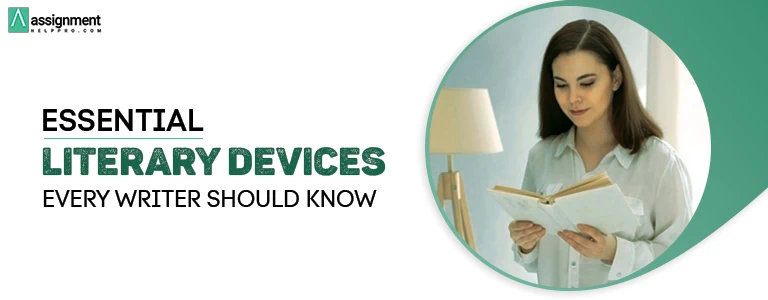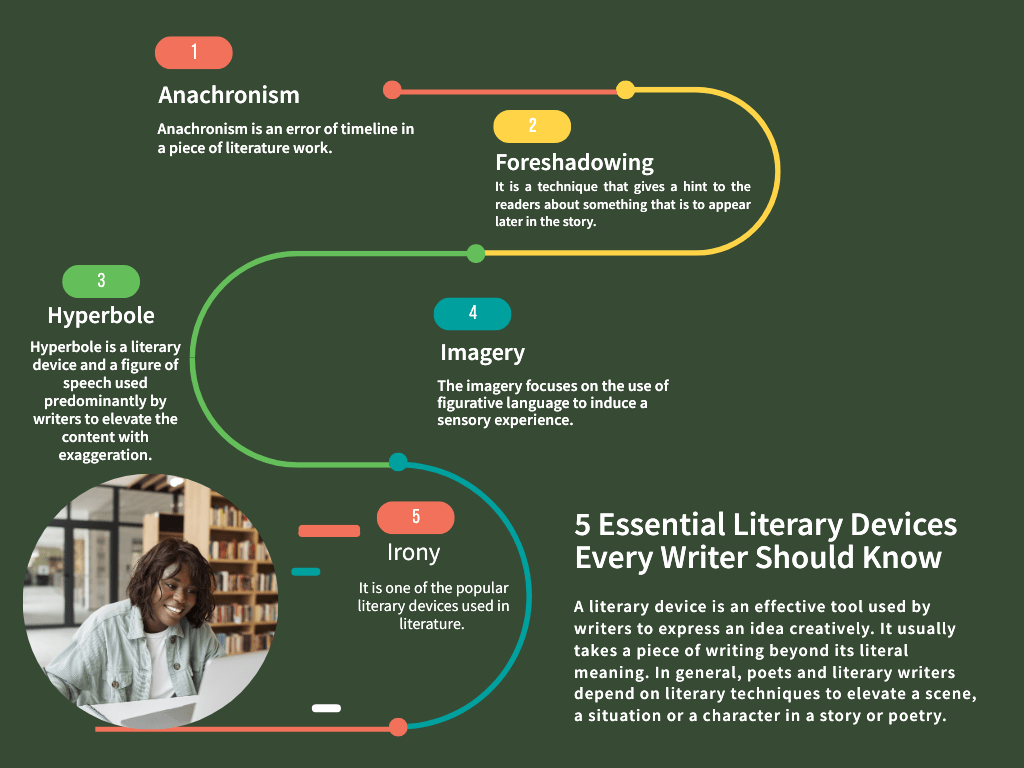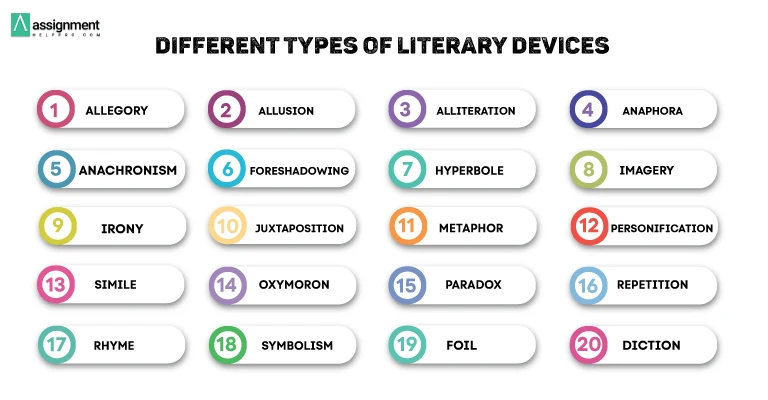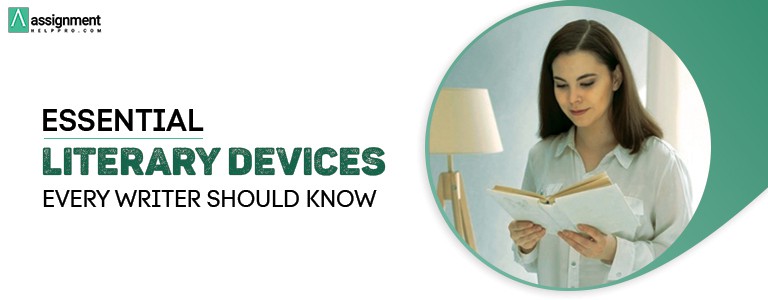What are the common literary devices in English? How to include those literary devices in your piece of writing? Check this post and learn about the various literary techniques.
A literary device is a useful tool that writers use to creatively express an idea. Usually, it goes beyond the literal meaning of a piece of writing. In most cases, literary writers and poets use literary techniques to bring out the best in a scene, a situation, or a character in a poem or story. The English language offers a variety of literary devices. Similes, metaphors, and personification are some of the most frequently used literary devices or figures of speech in works of literature. Moreover, the literary device represents creativity and adds more value to a work.

If you are a writer who wants to present your literary work in a creative and appealing manner, then try to incorporate literary devices effectively. Are you familiar with the various literary devices? In case, you have no idea, keep reading this blog and find out about the fundamental literary techniques you can use for your composition.
What are Literary Devices?
Literary devices are specific strategies for using language to convey a more nuanced meaning than the original literal meaning. In simple terms, they are powerful language techniques that give a new shade to a piece of writing. You can present your ideas in novel ways and encourage your readers to perceive them with the assistance of literary devices. Additionally, it is helpful to creatively establish a connection or relationship between things.
The literary devices not only create connections between things, but they also add richness to the literature with sound, emotion, sense, and narrative. For various purposes, there are numerous styles of literary devices available. They are typically used in writing at the sentence or paragraph level.

What are the Various Types of Literary Devices?
Basically, several writers use a wide range of literary devices across various genres such as prose and poetry. Since each literary device has a specific purpose, it should be implemented correctly in writing. For those who are unaware of the different styles of literary devices predominantly used by the writers, here we have shared a list. Go through them completely. The list will help you get a better understanding of the 20 essential literary devices with examples and will also explain to you the effective ways to use them in your work and improve your writing skills.

1. Allegory
Allegory is a literary device used for expressing complex ideas in an approachable and understandable manner. In simple terms, allegory is a work of art, maybe a painting or a story in which the characters, events, or images will act as symbols. The writers often use allegory to illustrate a historical situation, political situation, or spiritual truth.
Allegories have been used widely in literature works for centuries across different cultures. It is a literary device that is used in the Bible and other famous prose, poetry, and drama. Usually, it takes strong literary skills to write an effective allegory. You can use allegory to address controversial topics and make your readers understand your concepts or ideas.
Here is an example of allegory in literature.
Animal Farm written by George Orwell is a satirical allegorical novella. In this farm fable, animals run the society and reflect Leon Trotsky’s rise and the Russian Revolution. This story can be read as a fable of farm animals ruling a society or it can be considered to be the author’s criticism of communism.
In order to explore biblical allegories, you can check the Chronicles of Narnia, the Prodigal Son, the Good Samaritan, The Divine Comedy, the Adventures of Pinocchio, The Divine Comedy, etc. Other famous examples of allegory include Paulo Coelho’s The Alchemist, Yann Martel’s Beatrice, and Virgil, etc.
2. Allusion
The allusion is another popular literary device the writers use to reference any object outside of the literature work. The object of reference can be a fictional or a real person, quote, event, or any piece of work that contains artistic expressions. You can use allusions to build characters or storylines by creating strong bonds with well-known works.
Many people often use allusions in daily conversation. The allusion technique was also used by some popular literary writers to create a context in classical mythology and literature.
Here are some common examples of allusion.
- An allusion to Cupid – Arrow of love
- The allusion to Satan- Snake
- In The Little Mermaid, King Triton resembles the god of the sea, Poseidon.
3. Alliteration
Alliteration is a literary device that reflects the repetition of the same consonant sounds at the beginning of words. This technique creates a rhythm and grabs the attention of the readers to the lines. More commonly, in poems, alliteration refers to the repeated sound of the consonant in the stressed syllable of a line.
William Shakespeare in his Sonnet used alliteration techniques frequently. Other than the literature, alliteration has also been used widely in tongue twisters, fictional character names, and everyday speech.
Mentioned below are a few examples of alliteration
- Money Matters
- Picture Perfect
- Bugs Bunny
- Donald Duck
- She sells seashells by the seashore
- Then can I grieve at grievances foregone- Shakespeare’s Sonnet 30
4. Anaphora
The repetition of a phrase or a word at the beginning of phrases, sentences, or clauses is called Anaphora. It is one of the popular rhetorical and literary devices. The writers generally use anaphora to emphasize, reinforce, and convey meaning. It is a stylish literary technique that you can use while writing a poem, lyrics, prose, and a speech.
With the help of Anaphora, you can make your readers enjoy your piece of writing, evoke emotions, create a call to action, and emphasize a concept. One of the famous examples of Anaphora in literature is the opening sentence written by Charles Dickens in “A Tale of Two Cities”.
It was the best of times, it was the worst of times, it was the age of wisdom, it was the age of foolishness, it was the epoch of belief, it was the epoch of incredulity, it was the season of light, it was the season of darkness…
Other examples of Anaphora are
- Stay well. Stay happy.
- Be brief. Be gone.
- We came, we saw, we
5. Anachronism
Anachronism is an error in the timeline of a piece of literature work. In simple terms, anachronism is referred to as anything that is out of place and time. You can find anachronisms in paintings, literature, and other works.
In general, anachronism is considered to be an unintentional mistake or an error the writers commit due to carelessness and lack of research. But, at times, some writers smartly employ anachronism as a literary device in order to create a unique artistic effect in their work and grab the attention of the readers.
You can find the implementation of anachronism in William Shakespeare’s Julius Caesar play – Act 2 of Scene 1.
Brutus: “Peace! Count the clock.”
Cassius: “The clock has stricken three.”
This play dates back to 44 A.D. when the mechanical clock mentioned in the above dialogue had not been invented. But the mechanical clock was present during Shakespeare’s time. Hence, the clock mentioned in this play is an anachronism.
6. Foreshadowing
Another popular literary device used by novel writers and screenwriters to narrate a story is foreshadowing. It is a technique that gives a hint to the readers about something that is to appear later in the story. By using foreshadowing effectively, you can create suspense and tension for the readers.
Time, colors, weather, character reactions, dialogues, and the place are some common elements the writers use while foreshadowing. At times, the title of a literary work is used to foreshadow the plot events. You can find foreshadowing in many popular novels, TV shows, movies, and dramas. The foreshadowing can be direct or indirect.
Foreshadowing MovieTitle Examples: Murder on the Orient Express, Love in the Time of Cholera, A Telephone Call
The foreshadowing technique was used effectively in William Shakespeare’s Macbeth, John Steinbeck’s Of Mice and Men, and Flannery O’Connor’s A Good Man is Hard to Find.
7. Hyperbole
Hyperbole is a literary device and a figure of speech used predominantly by writers to elevate the content with exaggeration. It is often used for creating ironic, comic, or serious effects in literature work. In order to make the readers believe your ideas, you can use hyperbole in your piece of writing.
Hyperbole can be used in your everyday speech. Also, you can use this literary device while creating slogans for advertising campaigns and movie lines.
Some examples of hyperbole include
- I’m the King of the World- Titanic Movie
- Red Bull Gives You Wings – Red Bull advertisement
- I love you the moon and the back.
- I’m so tired that I can’t sleep for a week.
8. Imagery
The imagery focuses on the use of figurative language to induce a sensory experience. It is a literary device that helps to create a picture with words for a reader. The writers more commonly use figurative language and descriptive language to appeal to the reader’s senses, feelings, and emotions along with visual representations.
In order to evoke emotions in readers, you can use imagery to add depth to your story or poetry. Don’t overuse imagery because your readers may find it difficult to understand the purpose of your writing. Using imagery techniques, you can present your ideas in a straightforward manner.
Here are some examples of imagery in everyday speech.
- The kitten’s fur is milky.
- The light under the door looked buttery.
- My head is pounding like a drum.
9. Irony
A contradictory situation or a statement that reveals a reality that is different from the expectation is called irony. It is one of the popular literary devices used in literature. The common types of irony include verbal, dramatic, and situational irony.
The irony is generally used to portray a discrepancy between reality and expectation. With irony, the writers create humor, and suspense and also highlight a character or a theme in a literary work. In order to give a different experience to your readers or viewers, you need to be aware of their expectations of reality. Irony is a powerful literary technique that you can use as a plot device to showcase the behavior of characters and reveal twists.
Below are some examples of irony.
- Walking into an empty theater and saying “It’s too crowded”.
- A police station is burglarized.
- A retired CEO of the Crayola Company suffered from colorblindness.
- In Hansel and Gretel, the witch who intended to eat Hansel and Gretel is trapped in her own oven by the children.
10. Juxtaposition
A literary device that indicates a comparison or contrast is juxtaposition. Writers use this technique to create an ironic or dramatic contrast. It allows the readers to find out how the entities are similar and different.
In order to create a rhetorical effect, writers use juxtaposition by placing the two entities side by side to highlight the differences between the entities. It is used predominantly in novels and stories.
Listed below are a few examples of juxtaposition.
- Good and Evil
- Urban and Rural
- In the ‘Harry Potter Series’, Muggle and Wizard worlds
- In The Great Gatsby, East Egg and West Egg
11. Metaphor
A figure of speech that creates a comparison between two unlike things is called a metaphor. When used as a literary device, a metaphor creates a comparison without using “like” or “as”.
For creating a direct comparison between two different things, metaphor is used. Writers use metaphor while writing both prose and poetry. As a writer, you can earn a lot of benefits by using metaphors in your piece of work. With the help of metaphor, you can create imagery and evoke emotions.
Find below a few examples of metaphors.
- His heart of stone surprised me.
- Time is money.
- Love is a battlefield.
- You sit on a throne of lies.
12. Personification
Personification is a literary device that refers to nonhuman things with human characteristics. It is a form of metaphor that gives human attributes to an idea or thing. Writers use personification to create life.
Personification is a popular figure of speech that helps to demonstrate creativity, enhance imagination, and create humor. Poets predominantly use personification while writing poetry.
Here are a few examples of personification.
- My phone is not cooperating with me today.
- The wind is whispering.
- Time waits for no one
- Her eyes are not smiling.
13. Simile
Like a metaphor, a simile is also an effective figure of speech in which two dissimilar objects are compared together with the use of “as” or “like”. The simile explicitly creates a comparison between two different things. With the help of similes, you can generate thoughts and create imagery. You can use similes in your everyday conversation and also when writing poetry and prose.
Here are a few examples of similes.
- That poem is like a punch in the gut.
- Love is like a friendship caught on fire.
- Life is like riding a bicycle.
- The pizza is as flat as a pancake.
14. Oxymoron
Pairing two contradictory words together is called an oxymoron. As a literary device, an oxymoron creates an impression, enhances a reader, and also entertains the reader. Writers use oxymorons to gain the attention of the readers through the pairing of contradictory or opposing words.
An oxymoron is a figure of speech that enhances drama in writing, indicates irony, creates humor, and demonstrates linguistic skills. Apart from using oxymorons in literary works, you can also use oxymorons in your daily conversation and when writing titles and quotes.
Mentioned below are a few examples of oxymorons.
- She ate the whole piece of the pie.
- The carpenters left the table completely unfinished.
- I had a friendly fight with my sister.
15. Paradox
Paradox is a statement that appears to be contradictory at first, but it makes sense upon reflection. In simple terms, a paradox is made up of contradictory sentences or phrases.
It is a common literary device used to engage a reader to find out the underlying logic in a self-contradictory phrase or statement.
For the writers, paradox serves a lot of benefits. It is one of the excellent literary devices that help the writers to set up a conflict in literature work, and create situational or verbal irony. You can find paradox examples in a lot of movies.
Here are a few examples of paradoxes.
- Change is the only constant
- It is the beginning of the end
- “I’m going to make him an offer he can’t refuse.”- a dialogue from The Godfather
- “I had to come to prison to be a crook.”- is a dialogue from the Shawshank Redemption
16. Repetition
Repetition is a literary device that focuses on the intentional use of a word or a phrase multiple times in a speech or a piece of writing in order to create an effect. In order to make a repetition identifiable, the words or phrases should be repeated within a close limit. Repetition allows a sense of sound in your literary work and creates emphasis. Writers often use this literary technique to create clarity to an idea and make it memorable for the readers.
Don’t just use repetition for the sake of repeating a word or a phrase. Also, don’t overuse repetition in your literary work. When you use repetition properly, you can intensify your idea and generate a focus on your concept.
Mentioned below are a few examples of repetition.
- Hour to hour
- All for one and one for all
- James Bond– All James Bond Movies
- Stupid is as stupid does- Movie line from Forrest Grump
- Words, words, words– Hamlet
- The sad truth is that the truth is sad- Lemony Snicket
17. Rhyme
A rhyme is the repetition of different words with similar concluding syllables. It is an essential literary device used more often in poetry. A rhyme often appears at the end of the poetic lines. Remember, a rhyme focuses on sound and not spelling.
Rhyme is an essential literary device for poets, but it is not mandatory to include rhyming words or patterns in all poems. Writing rhyme is difficult, but to include rhyme in your poem, you need to be a master. In order to develop your rhyme writing skill, you can explore different poetic forms and types of rhyme, and then write creative and attractive poetry using any rhyme scheme.
A few examples of rhyme are mentioned below.
- Jack and Jill went up the hill
- Too cool for school
- Little Miss Muffet sat on her tuffet.
18. Symbolism
The use of symbols in literary work is called symbolism. It usually represents something that is beyond the literal meaning. In literature, the writers use symbols in the form of a word, character, object, action, or concept to evoke additional meaning and build a sensory experience.
Symbolism is an effective literary device that demonstrates the artistic use of language in a way to creates both literal and figurative meanings for words. Apart from the literary work, you can also find the usage of symbols in everyday life and movies.
Here are a few examples of Symbolism.
- Symbols that represent love- Red rose and heart
- In the movie Godfather, doors symbolize separation and transition
- In the movie Forrest Grump, feathers symbolize the beginnings and endings.
19. Foil
Foil is a literary device the writers often use to illustrate or reveal the traits and values of one character by comparing it with another character. In order to draw the attention of the readers toward the protagonist, the writers implement a foil technique in their literary work. It is one of the effective techniques used to reveal the strengths and weaknesses of a character in a story.
In the films, foil characters are used to entertain the audience through drama, humor, and empathy. Literary writers often use foil to showcase the difference between two characters.
Mentioned below are a few examples of foil traits and foil character pairs in popular movies and literature.
- Generous and stingy
- Ambitious and content
- Foolishness and Wisdom
- Harry Potter and Draco Malfoy in the Harry Potter series
- Edward Cullen and Jacob Black in the Twilight series
- Sherlock Holmes and Dr. Watson in the Sherlock Holmes series
- Brutus and Cassius in William Shakespeare’s Julius Caesar play
20. Diction
Diction is a literary device that refers to the linguistic choices used to convey a point of view, an idea, a thought, or a story in an effective way. In general, the voice and style of literary work are identified only based on the writer’s vocabulary and the arrangement of words. Therefore, it is mandatory to understand diction and how to use diction effectively in a piece of writing.
Diction has a close association with characterization. You can use diction to represent the values, attitudes, and ideals of a literary character along with their outer appearance.
Diction is one of the effective devices used to communicate with readers. It can be used in all forms of writing, from poetic to concise wording. Your diction can be formal, informal, poetic, colloquial, abstract, slang, pedantic, and concrete.
Here are a few examples of diction.
- I am tired because I was binge-watching a show last night- Colloquial diction
- Text me when you are ready to go home, so I can pick you up Informal diction
Conclusion
Till now, we have seen some essential literary devices that you can use in your academic writing. We hope you have gained a better understanding of this concept. Other than the literary techniques mentioned in this post, there are still a lot of literary devices available in the English language for writing prose and poetry. If you struggle to tune your work with the right literary device, then reach out to us.



